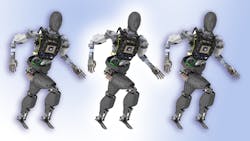Disaster response robots require multiple layers of software to explore and interact with their environments, use tools, maintain balance and communicate with human operators. In the Virtual Robotics Challenge (VRC), competing teams applied software of their own design to a simulated robot in an attempt to complete a series of tasks that are prerequisites for more complex activities.
Twenty-six teams from eight countries qualified to compete in the VRC, which ran from June 17-21, 2013. DARPA had allocated resources for the six teams that did best, but in an interesting twist, good sportsmanship and generosity will allow members of the top nine teams, listed below, to move forward:
1. Team IHMC, Institute for Human and Machine Cognition, Pensacola, Fla. (52 points)
2. WPI Robotics Engineering C Squad (WRECS), Worcester Polytechnic Institute, Worcester, Mass. (39 points)
3. MIT, Massachusetts Institute of Technology, Cambridge, Mass. (34 points)
4. Team TRACLabs, TRACLabs, Inc., Webster, Texas (30 points)
5. JPL / UCSB / Caltech, Jet Propulsion Laboratory, Pasadena, Calif. (29 points)
6. TORC, TORC / TU Darmstadt / Virginia Tech, Blacksburg, Va. (27 points)
7. Team K, Japan (25 points)
8. TROOPER, Lockheed Martin, Cherry Hill, N.J. (24 points)
9. Case Western University, Cleveland, Ohio (23 points)
The top six teams earned funding and an ATLAS robot from DARPA to compete in the DRC Trials in December 2013 (DARPA is also funding several other “Track A” teams to construct their own robot and compete in the Trials). The Trials are the second of three DRC events, and the first physical competition.
In a demonstration of good sportsmanship, Jet Propulsion Laboratory, which also has a DARPA-funded Track A effort with its own robot, decided to merge its two efforts and offer the bulk of the resources it earned in the VRC to other teams. DARPA split the freed resources between the next two teams:
· The robot associated with the JPL win and some funding now goes to TROOPER (Lockheed Martin).
· Additional funds are being allocated to a newly formed team of Team K and Case Western. That team, now known as HKU, will use an ATLAS robot generously donated to it by Hong Kong University to participate in the DRC Trials in December.
Thus, in total, seven teams with ATLAS robots and DARPA support will be going to the DRC Trials, where they will compete with other teams with their own robots.
VRC teams were evaluated based on task completion and effective operator control of the robots in five simulated runs for each of three tasks (15 total timed runs) that addressed robot perception, manipulation and locomotion. The tasks included: entering, driving and exiting a utility vehicle; walking across muddy, uneven and rubble-strewn terrain; and attaching a hose connector to a spigot, then turning a nearby valve. To simulate communications limitations in a disaster zone, the VRC imposed a round trip latency of 500 milliseconds on data transmission, and varied the total number of communications bits available in each run, from a high of 900 megabits down to 60 megabits.
To conduct the VRC, DARPA funded the Open Source Robotics Foundation to develop a cloud-based simulator that calculates and displays the physical and sensory behaviors of robots in a three-dimensional virtual space, in real time. The simulator allowed teams to send commands and receive data over the Internet to and from a simulated ATLAS robot—information very similar to what would be sent between a physical robot and its operator in the real world.
“The VRC and the DARPA Simulator allowed us to open the field for the DARPA Robotics Challenge beyond hardware to include experts in robotic software. Integrating both skill sets is vital to the long-term feasibility of robots for disaster response,” said Gill Pratt, DRC program manager. “The Virtual Robotics Challenge itself was also a great technical accomplishment, as we have now tested and provided an open-source simulation platform that has the potential to catalyze the robotics and electro-mechanical systems industries by lowering costs to create low-volume, highly complex systems.”
Atlas Robot
Developed by Boston Dynamics, Atlas is a high mobility, humanoid robot designed to negotiate outdoor, rough terrain. Atlas can walk bipedally leaving the upper limbs free to lift, carry, and manipulate the environment. In extremely challenging terrain, Atlas is strong and coordinated enough to climb using hands and feet, to pick its way through congested spaces. Articulated, sensate hands will enable Atlas to use tools designed for human use. Atlas includes 28 hydraulically-actuated degrees of freedom, two hands, arms, legs, feet and a torso. An articulated sensor head includes stereo cameras and a laser range finder. Atlas is powered from an off-board, electric power supply via a flexible tether.
About the Author

Sam Davis Blog
Editor-In-Chief - Power Electronics
Sam Davis was the editor-in-chief of Power Electronics Technology magazine and website that is now part of Electronic Design. He has 18 years experience in electronic engineering design and management, six years in public relations and 25 years as a trade press editor. He holds a BSEE from Case-Western Reserve University, and did graduate work at the same school and UCLA. Sam was the editor for PCIM, the predecessor to Power Electronics Technology, from 1984 to 2004. His engineering experience includes circuit and system design for Litton Systems, Bunker-Ramo, Rocketdyne, and Clevite Corporation.. Design tasks included analog circuits, display systems, power supplies, underwater ordnance systems, and test systems. He also served as a program manager for a Litton Systems Navy program.
Sam is the author of Computer Data Displays, a book published by Prentice-Hall in the U.S. and Japan in 1969. He is also a recipient of the Jesse Neal Award for trade press editorial excellence, and has one patent for naval ship construction that simplifies electronic system integration.


